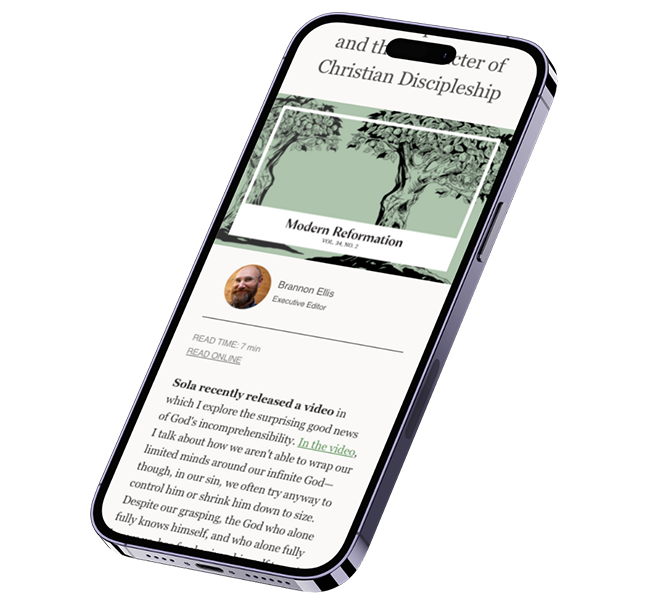In recognition of the 500th anniversary of John Calvin's birth, Modern Reformation editors have solicited essays from a number of authorities on Calvin's life and work. Not all of our writers are "Calvinists" (that is, they would not all necessarily agree with him or follow in his theological footsteps), but each has identified a particular point of Calvin's thought that helps contribute to an overall perspective of Calvin's influence in his time and ours. We're grateful to these writers, some of whom might not normally appear in our pages, for lending us their own words as we contemplate the many faces of John Calvin.
Although Archbishop Thomas Cranmer was in significant and amicable correspondence with John Calvin during Edward VI's reign, the enormous influence of Calvinism on the English Church occurred after the death of Queen Mary (1558) with the return of the "Marian exiles" who had lived among Calvin scholars on the continent. Archbishop Edmund Grindall (d. 1583) was one of the exiles who had lived in Frankfurt until Elizabeth succeeded Mary. He had tried to mediate among the exiles and was regarded as a "moderate" Calvinist. However, he so favored attention to Scripture on the part of Puritan conventicles called "prophesyings" that he refused Queen Elizabeth's demand to shut them down and was forced to relinquish much of his authority. The high water mark of Calvinism in England is considered to be under Grindall's successor, John Whitgift (1583-1604). Although Grindall was a vigorous opponent of the Puritan Thomas Cartwright in debates at Cambridge, he showed himself to be a staunch defender of episcopacy against Presbyterian claims. Yet he was a decided Calvinist in theology if not in polity. At that time, Cambridge University was beset by a most acrimonious division over questions of indefectibility of grace, whether it applied to all who were regenerate and justified or only to the elect. The latter was deemed "Augustinian" and the former "Calvinist."
Whitgift helped formulate the Lambeth Articles of 1596, which leaned toward the Calvinist side of the debate. In spite of careful qualifications as to the authority of the articles, they brought down a heavy barrage of criticism from the queen, Lord Burleigh, and leading scholars across England. After 1596, Calvinism was never again the leading theological party in England.
The most remarkable evidence of the trend away from Calvinism (and from the Reformation) was the conference led by Bishop William Laud (1573-1645) and "Fisher" the Jesuit. It had been called by the king to settle the claims of Roman Catholicism against those of the Church of England. Laud, then bishop of St. David's, was the English Church's spokesman and later archbishop. In defending his church against Roman Catholic claims, he never mentions either the Thirty-nine Articles or the doctrine of justification.
The very term "Calvinism" is an awkward one, especially in light of the ongoing debate as to how much and on what issues later Calvinists differed from Calvin himself. In the matter of the Eucharistic presence, there is a consensus that Cranmer's gradual change of mind led him from Luther's position to something closer to that of Calvin.
The Synod of Dort (1618-19) gave to Calvinism a precise definition: (l) Total depravity (fallen humans cannot choose to serve God); (2) Unconditional election (God's choice of the elect is not conditional on any action by them); (3) Limited atonement (Christ died for the elect only); (4) Irresistible grace (divine grace cannot be rejected by the elect); and (5) Perseverance of the saints (once elect, always elect). These issues had divided "Calvinists" from "Remonstrants," but the political and military divisions made open dialogue impossible. The Remonstrants were barred from or refused to attend the synod and were condemned on the basis of their writings. Some followers of Calvin were aware that Calvin himself in his Institutes put the question of election and predestination in the section on soteriology (how we are saved) and not in the doctrine of God (how God manages things). These followers remained unwilling to press the logic of doctrines where Scripture is silent.
King James I was himself a Calvinist and sent five delegates to the synod. They issued the following statement attempting to qualify the one-sided victory at Dort:
We suggest, moreover, that of those things which are established on the sure foundation of the Word of God, there are some, which ought not to be promiscuously inculcated upon all, but touched in the proper time and place with tenderness and judgment. One of them is the sublime mystery of predestination, sweet indeed and most full of comfort, but to them who are rooted in the faith, and exercised in holy living; for to such only will it prove an unfailing bulwark in the midst of the grievous struggles of the conscience.
"Arminianism" became the term used to describe much of the reaction against Dort in the subsequent history of the Church of England. The term itself derives from James Arminius who had died in 1609. In spite of what he himself taught, his name has been given to the belief that humans are naturally free before grace, free when accepting or rejecting grace, thereby giving credence to the presumption that we are free when we sin. Overlooked was Jesus' warning that "he who sins is a slave to sin….When the Son makes you free you are free indeed" (John 8:34, 36). Arminius never taught that we are free when we sin, but that we are in bondage and slavery. We are "free" to reject God in the sense that our wills are uninhibited and unconstrained in the choice to reject him, but the will is itself in bondage until the Son makes it free. Our wills are not free simply because they are unrestrained.
This human and fallen pretension that we are born free began to work its way through seventeenth-century England in R. Montague's Appello Caesarem (1626), the works of Jeremy Taylor (1613-67) and Henry Hammond (1605-60), the anonymous The Whole Duty of Man, and into the eighteenth century through the Cambridge Platonists and the Latitudinarians. Samuel Taylor Coleridge (1772-1834) looked back to Jeremy Taylor as a symbol of the doctrinal drift of two centuries: "Socinianism is as inevitable a deduction from Taylor's scheme as Deism or Atheism is from Socinianism." In the eighteenth century, there was a revival of Calvinism in the works of Anglican evangelicals: Augustus Toplady (1740-78), author of the hymn "Rock of Ages"; and more moderate Calvinists such as John Newton (1726-1807), author of "Amazing Grace," Selina, countess of Huntingdon (1707-91), and George Whitefield (1714-70).
Fear of antinomianism was an important factor in discrediting Calvinism with its claim to free grace without requiring works for justification. Whereas Calvin had counseled acceptance, obedience or exile under tyranny, his successor Theodore Beza (1519-1605) affirmed the option of rebellion. In 1628, the assassination of the duke of Buckingham gave rise to fear that rebellion and lawlessness would be products of Calvinism. The English Civil War increased this fear and encouraged Pelagianism as a counter to social disruption. The eighteenth century also fed the fear of antinomianism and the belief in the role of religion to quell sin in society. This very fear led John Wesley to embrace the term "Arminian," which provoked a serious split among evangelicals. Wesley even dropped the article on predestination in the Thirty-nine Articles from the Methodist articles.
Since the eighteenth century, that aspect of Arminianism, which assumed freedom in the initial situation, has been a common element in most of Anglicanism, with the exception of Archbishop William Temple (1881-1944). The pastoral cruelty of assuming sinners are free instead of in bondage to sin was caught by S. T. Coleridge's dictum that Calvinism "is as a lamb in the wolf's skin to the [Arminian's] wolf in the lamb's skin."
2 [ Back ] C. Hardwick, A History of the Articles of Religion (Philadelphia: G. Bell, 1852), 186.
3 [ Back ] C. F. Allison, The Rise of Moralism (Vancouver: Regent College, 2003).
4 [ Back ] The Complete Works of S. T. Coleridge, vol. V (New York: Harper, 1876), 172.
5 [ Back ] Coleridge, 200.





